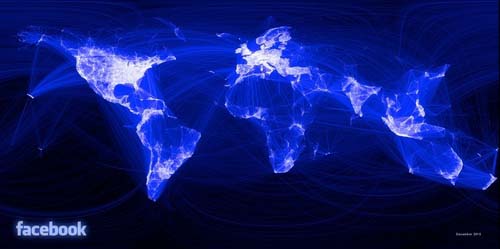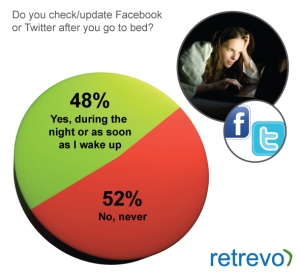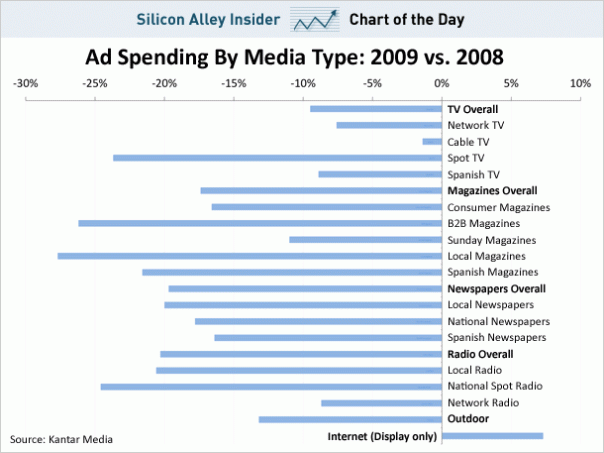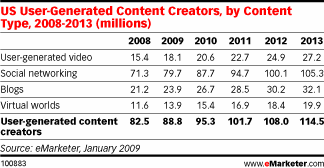What Do 10 Million Facebook Friendships Look Like?
In Technology, social media, marketing, facebook, Entertainment, Statistics, online marketing, Social Media News on January 9, 2011 at 7:13 am
Recently, an intern working on Facebook’s data infrastructure engineering team took a sample of nearly 10 million pairs of friends from Facebook’s data warehouse and plotted out their relationships. The result? This intriguingly beautiful image and an accurate map of the world.
Here are the thoughts that Paul shared about the image and its creation:
After a few minutes of rendering, the new plot appeared, and I was a bit taken aback by what I saw. The blob had turned into a surprisingly detailed map of the world. Not only were continents visible, certain international borders were apparent as well. What really struck me, though, was knowing that the lines didn’t represent coasts or rivers or political borders, but real human relationships. Each line might represent a friendship made while travelling, a family member abroad, or an old college friend pulled away by the various forces of life.
We’d like to see an image of each individual Facebook user pinpointed on a map and see if it is attractive.
EVANS MEDIA GROUP, KANSAS CITY SOCIAL MEDIA, KANSAS CITY'S SOCIAL MEDIA AGENCY, MOBILE MARKETING, NEW MEDIA, OLD MEDIA, PAUL EVANS, SARA PAXTON, SOCIAL MEDIA, SOCIAL MEDIA AGENCY,SOCIAL MEDIA STATS
Social Media is a Science. Rocket Science, in fact.
In advertising, Automotive, Business, collision repair, Economy, facebook, LinkedIn, marketing, News, Security, social media,Statistics, Technology, tv, twitter on March 18, 2010 at 11:57 am
Yes, that’s what I said. Rocket science. Shaking your head in disbelief? Really?
Well, would you design or develop your own website? Or would you look to a web development company or web designer to complete that piece of your marketing toolkit.
web development company or web designer to complete that piece of your marketing toolkit.
 web development company or web designer to complete that piece of your marketing toolkit.
web development company or web designer to complete that piece of your marketing toolkit.
Likewise, would you shoot your own television commercial or buy or place your own media spots to air that commercial? And, if you did, would you be convinced that you are targeting your demographic and getting the best bang for your marketing buck?
Didn’t think so.
Recently, we met an attorney and he told us that we have a unique skill set as creative and marketing minds. In fact, he told us that we were like rock stars or athletes since our product exists between our temples. Our product is our intellectual property. What value does that have? What price tag can you associate with such a product? We know our value, but struggle with that in this ever changing world of new media, but we left the conversation feeling like we need to take out some hefty life insurance policies on our brains.
intellectual property. What value does that have? What price tag can you associate with such a product? We know our value, but struggle with that in this ever changing world of new media, but we left the conversation feeling like we need to take out some hefty life insurance policies on our brains.
 intellectual property. What value does that have? What price tag can you associate with such a product? We know our value, but struggle with that in this ever changing world of new media, but we left the conversation feeling like we need to take out some hefty life insurance policies on our brains.
intellectual property. What value does that have? What price tag can you associate with such a product? We know our value, but struggle with that in this ever changing world of new media, but we left the conversation feeling like we need to take out some hefty life insurance policies on our brains.
Just as when the internet revolutionized the advertising and marketing agencies in the 90s, and everyone sat back and waited for the established ad agencies to come in and eat their lunch, it didn’t happen. The eager college grads designed websites for big companies and tried to figure out how this new thing called the internet. The media world is being transformed again, and the question is will ad agencies leverage their client relationships in the social space? It didn’t happen with web development and design. Why you ask? Traditional agencies are about creativity not technology and they left web design and development up to the rocket scientists and we predict the same will occur with social media. Ad agencies will work with other entities that are comfortable in the space, and where the learning curve is short. Given the recent downturn of their industry, they cannot afford to take any unnecessary risks either.
The risks to not adapting to the shift in the market are great, though many are resisting and in fact, ignoring the trends, but then again, there are still nearly 40% of small businesses that do not have websites in 2010!
 Consumer behavior is evolving at a frenzied pace. One in which the internet marketers find overwhelming and even those social media strategists. Why? Keeping your finger on the pulse of the marketing and advertising industry is a full time job in itself. Watching and identifying trends, seeking out new mediums to communicate and developing effective messages for those mediums is another. Here is a 50,000 foot perspective.
Consumer behavior is evolving at a frenzied pace. One in which the internet marketers find overwhelming and even those social media strategists. Why? Keeping your finger on the pulse of the marketing and advertising industry is a full time job in itself. Watching and identifying trends, seeking out new mediums to communicate and developing effective messages for those mediums is another. Here is a 50,000 foot perspective.
1. The web is social. 48% of the 1,000 respondents in a recent study commissioned by Retrevo indicated that they check in on social media activity when they are awakened in the middle of the night. Granted, this is heavily skewed by night owls that are in the 25 and under bracket, but a large portion of many big brands target market are online and engaged with social media networks at that time. 61% of Facebook users are 35 and older. Still think your customers aren’t using social media?
2. There’s a reason that they call it “old media.” Media industry ad revenues declined 12% year-over-year to $125.3 billion in 2009, according to a report issued by Kantar Media. The only major growth area? Online ad spending. TV ad spending fell 10%, with spot spending falling off dramatically due to the lack of political ads from 2008. Magazines dropped 17%. Newspapers and radios each dropped 20% and outdoor advertising fell 13%.
3. User content is key to the online experience of millions of US Internet users. Ranging from communications to e-commerce to entertainment, consumers are increasingly in charge of the creation, distribution, and consumption of digital content. The number of people who consume user-generated content exceeds the number of creators. This is true of any content loop – there are always more spectators than active participants. The difference? User generated content is affordable, accessible and integrates well with mass participation. As a result, the gap between creators and consumers is smaller than in traditional media. The downside? The craze of content generation is not likely to produce commensurate rewards for marketers or site publishers, since advertisers shy away from attaching their brands to unpredictable content.
What does this mean for brands and marketers? It means it is even more difficult to manage because the assets from media that traditional media used to control (print, broadcast, online publishing) is migrating to channels that they don’t control and most importantly, can’t. Why, you ask? Because the fun new media that everyone is all abuzz about is invite only.
The media world is changing, and predominantly, online media. The solution? Realize the full-potential of the over 82 million user content creators. How? Marketers and site publishers must be willing to work together. What does this mean for you and your brand? It means taking risks. Something no one wants to do in the current economy, and something few businesses every want to do with their marketing strategies or brand. The other piece of it? It mandates becoming very savvy in the social media segment, finding safe havens with social media channels, and taking refuge among these content creators that you’ve forged relationships with. Until these changes occur, user generated content will remain a phenomenon and the popular appeal eclipses its commercial possibilities.
So, how does this make social media rocket science? The chart below shows that 79.7 million people created content on social networks last year. What does that mean for you? It means that 23.9 million people posted blogs. 18 million videos were uploaded. More than 13 million people participated in virtual worlds, yielding a number of over 88 million content creators, which counts everyone who generated content at least monthly. Just because it’s call the social space, doesn’t men it is like outer space and there is nothing out there. It’s crowded out there. There is a lot of competition, millions of businesses vying for attention. Plenty of things to crash into.
It’s a rocket ship alright. And in order to launch it, guide it and land it safely, you need a scientist. Choose wisely. There are many “experts” out there that may get you off the pad, but solid piloting skills? Not so much. Look for a team that can provide the telemetry you need to effect a successful mission of launching or guiding your brand in the social space.
 Written by: Sara Paxton, managing partner, CTO, and Social Media Officer of Evans Media Group, Kansas City’s Social Media Agency, a boutique agency located in Overland Park, KS that specializes in traditional marketing, social media marketing, online marketing, and public relations.
Written by: Sara Paxton, managing partner, CTO, and Social Media Officer of Evans Media Group, Kansas City’s Social Media Agency, a boutique agency located in Overland Park, KS that specializes in traditional marketing, social media marketing, online marketing, and public relations.
CASE STUDIES, FACEBOOK, SOCIAL MEDIA, SOCIAL MEDIA MARKETING, SOCIAL MEDIA ROI, STATS FOR SOCIAL MEDIA, TWITTER
What’s the Social Media ROI? Here you go.
In advertising, Business, Economy, facebook, LinkedIn, marketing, social media, Statistics, Technology, twitter on March 11, 2010 at 7:10 pm Facebook fans and Twitter followers of a brand are more likely to not only recommend, but they are also more likely to buy from, those brands than they were before becoming fans/followers.
Facebook fans and Twitter followers of a brand are more likely to not only recommend, but they are also more likely to buy from, those brands than they were before becoming fans/followers.
A study of over 1,500 consumers by market research firm Chadwick Martin Bailey and iModerate Research Technologies found that 60% of Facebook fans and 79% of Twitter followers are more likely to recommend those brands since becoming a fan or follower. And 51% of Facebook fans and 67% of Twitter followers are more likely to buy the brands they follow or are a fan of.
Data was collected from 1,504 adults (aged 18 and over) via a nationally representative online survey questionnaire by Chadwick Martin Bailey Feb. 8 and 9.





No comments:
Post a Comment